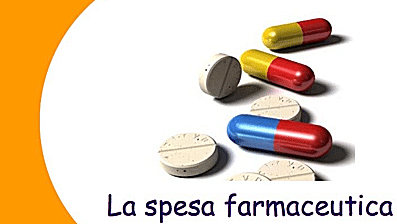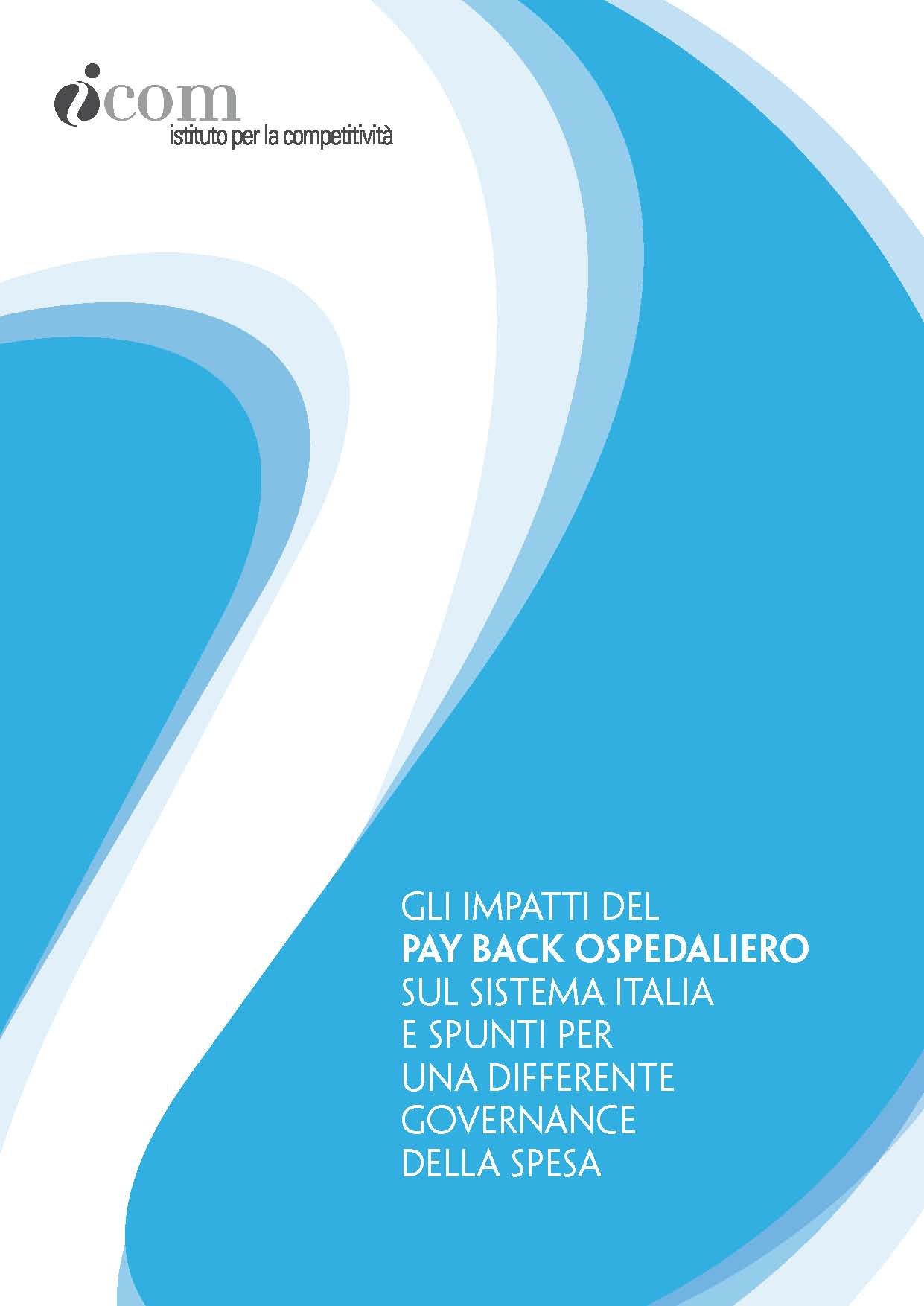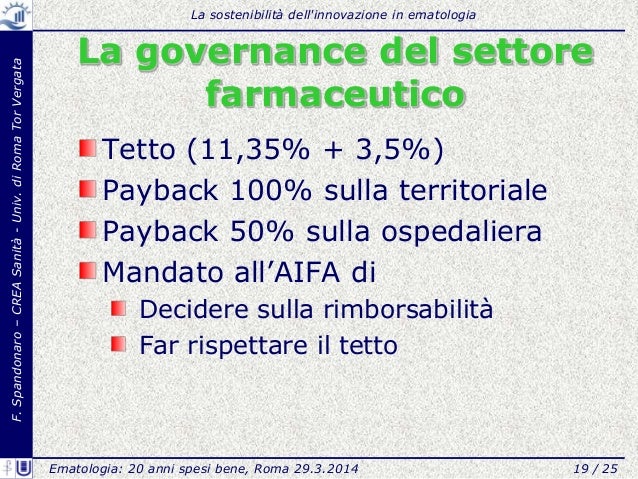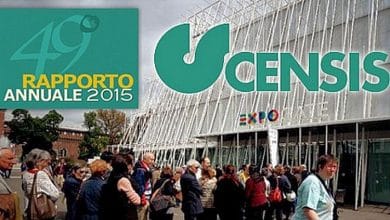
by Stefano da Empoli President of the Institute for Competitiveness – I-Com.
 Born as a public finance tool to control public expenditure and make companies accountable, in fact since its first application, starting from the breakthrough related to 2013 (certified in the second half of 2014), the payback on hospital pharmaceutical expenditure is transforming, also due to the way it is designed (and due to the ceiling from the outset being too low compared to the system's needs), into a cleaver that basically falls on a very specific category of pharmaceutical companies: companies and are committed to bringing new products to the world and Italian markets (many of which are among the main investors in production and research in Italy and a large part of those that the Renzi government met last October at Palazzo Chigi, to make Italy the main hub for industry at European level).
Born as a public finance tool to control public expenditure and make companies accountable, in fact since its first application, starting from the breakthrough related to 2013 (certified in the second half of 2014), the payback on hospital pharmaceutical expenditure is transforming, also due to the way it is designed (and due to the ceiling from the outset being too low compared to the system's needs), into a cleaver that basically falls on a very specific category of pharmaceutical companies: companies and are committed to bringing new products to the world and Italian markets (many of which are among the main investors in production and research in Italy and a large part of those that the Renzi government met last October at Palazzo Chigi, to make Italy the main hub for industry at European level).
This evident dissonance (we believe unaware) between the aspirations of the Government, which deserves credit for having been the first since time immemorial to have clear the contribution of the pharmaceutical industry to the competitiveness of the country system (on which the analysis contained in Chapter 1 focuses), and the perversion of an instrument such as that of the payback on hospital pharmaceutical expenditure which recalls the profile of the Leviathan of Hobbesian (but also Stalinian) memory makes clear the information gap that exists today and the imperative to fill it.
This is what we intend to do (or at least start doing) in this study, in which we describe the functioning of the tool within the current governance of pharmaceutical expenditure (chapters 2 and 3), analyze its systemic impact with respect to the main expenditure variables (chapter  4) and the one on the financial statements of the companies that participated in our research sample (chapter 5), we study the profiles of constitutional, community and administrative legitimacy (chapter 6), also on the basis of the very recent dispute with the Lazio Regional Administrative Court, which largely proved the companies right, and finally we give the floor to the companies to tell the impact of the mechanism and its critical profiles through the words of their respective CEOs (and not just with numbers) (chapter 7).
4) and the one on the financial statements of the companies that participated in our research sample (chapter 5), we study the profiles of constitutional, community and administrative legitimacy (chapter 6), also on the basis of the very recent dispute with the Lazio Regional Administrative Court, which largely proved the companies right, and finally we give the floor to the companies to tell the impact of the mechanism and its critical profiles through the words of their respective CEOs (and not just with numbers) (chapter 7).
Finally, we list the 5 main criticalities that we have found based on the analysis conducted and the elements provided by the companies and we indicate some policy ideas for modifying or, more hopefully, overcoming the mechanism in a future that must however necessarily be close. To avoid the two effects that we fear most of all for the Italian system: a drop in the current levels of investment in production and R&D in the industrial sector that has performed best in Italy in the last decade and the delay, or in the worst cases, the renunciation of the introduction of new H-level drugs, dashing the hopes of hundreds of thousands of patients.
 All this was possible thanks to the non-conditioning contribution of 8 companies (AbbVie, Amgen, BMS, Eli Lilly, Janssen, MSD, Pfizer and Roche) who made a considerable amount of data available to the project in a very short time, thanks to which it was possible to conduct a much more accurate analysis than we could have done in their absence. To cite just two results of the micro analysis, we would never have suspected that the payback could be worth more than the sum of IRES and IRAP paid by the companies themselves (even 117% in 2014). Or that a new drug can contribute more than double that of existing drugs in the first two years after its launch on the shelf, in a clear reversal not only of every meritocratic rule but above all of that of common sense. Just what we would like Italian politics to recover on a key issue at the intersection of health, competitiveness and public finance.
All this was possible thanks to the non-conditioning contribution of 8 companies (AbbVie, Amgen, BMS, Eli Lilly, Janssen, MSD, Pfizer and Roche) who made a considerable amount of data available to the project in a very short time, thanks to which it was possible to conduct a much more accurate analysis than we could have done in their absence. To cite just two results of the micro analysis, we would never have suspected that the payback could be worth more than the sum of IRES and IRAP paid by the companies themselves (even 117% in 2014). Or that a new drug can contribute more than double that of existing drugs in the first two years after its launch on the shelf, in a clear reversal not only of every meritocratic rule but above all of that of common sense. Just what we would like Italian politics to recover on a key issue at the intersection of health, competitiveness and public finance.
Since the introduction of The impact of hospital payback on the ITALIA and SPUNTI system for a different governance of expenditure I-Com study 16-07-2015 Year: 2015 N° pages: 88 Authors: Cinzia ARU, Silvia COMPAGNUCCI, Stefano DA EMPOLI, Maria Rosaria DELLA PORTA, Davide INTEGLIA, Eleonora MAZZONI
Related news: Court of Auditors. Between 2008 and 2015 cut 17.5 billion to healthcare. Taxes up and investments down CDC Report on Territorial Finance
Pay-back 2013, Federfarma: 0.64% remains pending appeal from pharmacies





